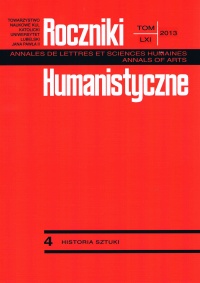The representation of human corporeality in Peter Cavallinis paintings. The synthesis of Roman classicism and Byzantine tradition in depicting a human being
Abstrakt
Wyobrażenie ludzkiej cielesności w malarstwie Piotra Cavalliniego. Synteza rzymskiego klasycyzmu i bizantyńskiej tradycji obrazowania ludzkiej tożsamości
Mistrz Piotr Cavallini (1240/50-1330), rzymianin z urodzenia, wychowania i artystycznej sławy, pracował w swoim mieście rodzinnym oraz w innych centrach kształtujących modele artystyczne początku XIV wieku, np. na dworze Karola II Andegaweńskiego w Neapolu. Pontyfikat papieża Bonifacego VIII i przygotowania Rzymu na Rok Jubileuszowy 1300 stały u się szczególnie istotnym impulsem odnowienia i odrodzenia sztuki w Świętym Mieście. Dzieła Piotra Cavalliniego w Rzymie syntetyzują cechy określane w historii malarstwa jako rzymski klasycyzm inspirowany głównie tradycją rzeźby i reliefu starożytnego Rzymu. Jednak Lorenzo Ghiberti wywyższył malarstwo Piotra pośród ówczesnych malarzy określając je jako maniera greca. Zatem można je porównywać z zachowanymi w tradycji rzymskiej ikonami. Maniera classica i maniera greca stanowią dwa odmienne nurty w formowaniu i ukazywaniu ludzkiej cielesności. Piotr Cavallini nawiązywał do jednej i drugiej tradycji nie kopiując ani jednej ani drugiej. Dostrzegalne są w jego malarstwie dążenia do tego, aby powiększyć przestrzeń i miejsce zdarzeń, aby stworzyć iluzję swobodnego poruszania się postaci w ukazanych zdarzeniach. Wizualizacja materialnej cielesności w naturalnym, materialnym otoczeniu architektonicznego wnętrza lub przestrzeni otwartej jest dowodem pogodzenia przez malarza tradycji łacińskiej, rzymskiej z grecką, bizantyńską. Artysta na modelach bizantynizujących twarzy wypracował iluzje nowej cielesności nasączonej emocjami, indywidualnymi oznakami fizjonomii, cechami wieku temperamentu, zaznaczając wewnętrzne, psychiczne cechy indywidualne ukazywanych postaci. Badacze malarstwa Cavalliniego wskazują na proto-renesansowe cechy, co potwierdza styl malowanej cielesności zarówno w jej materialnym odwzorowaniu, jak i w duchowych oraz psychicznych implikacjach widocznych w malarstwie freskowym, mozaikach i tablicach.
Copyright (c) 2013 Roczniki Humanistyczne

Utwór dostępny jest na licencji Creative Commons Uznanie autorstwa – Użycie niekomercyjne – Bez utworów zależnych 4.0 Międzynarodowe.





